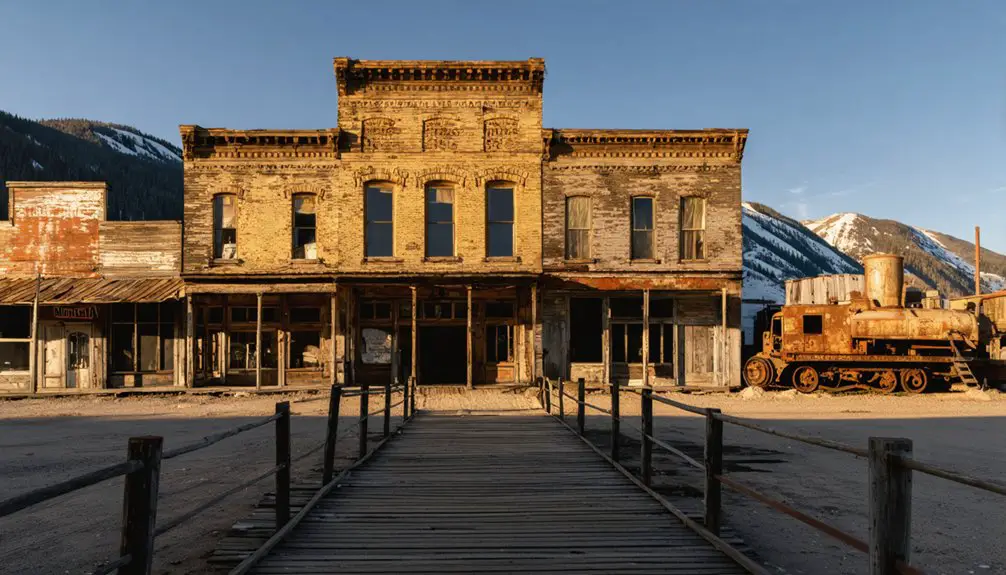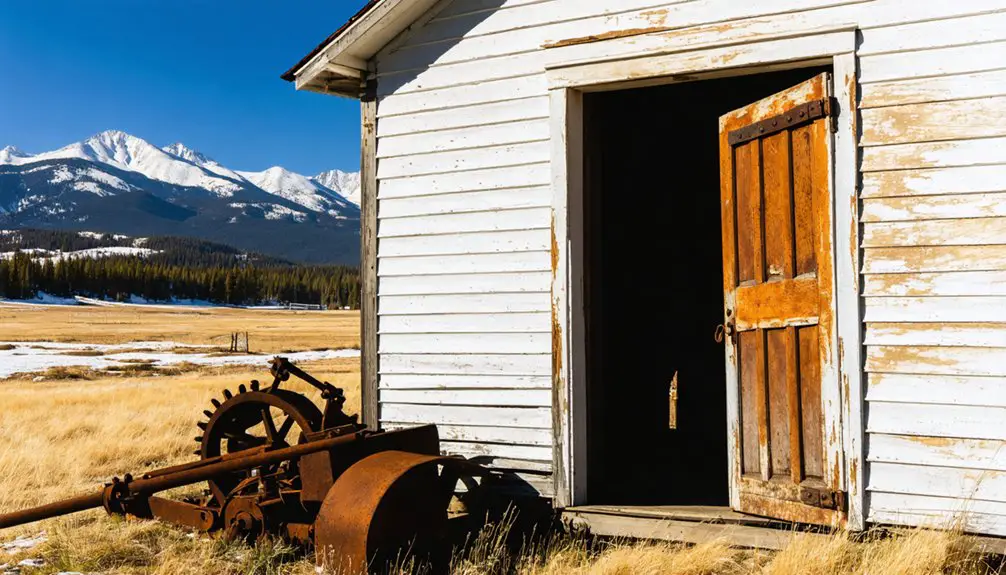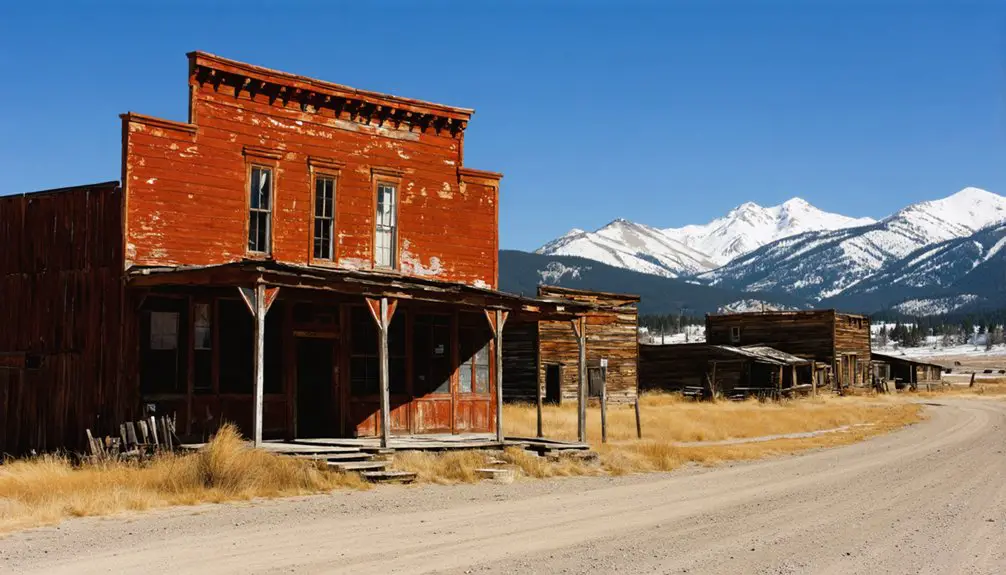You’ll find Mammoth perched at 6,319 feet in Montana’s Boulder Mountains, where silver strikes in 1877 transformed this remote outpost into a bustling boomtown of over 1,000 residents. The Mammoth Mining Company established extensive infrastructure, including 18,000 feet of tunnels and a 20-stamp mill, before the 1893 silver crash emptied the town. Today, weathered ruins and abandoned mine structures offer a compelling window into Montana’s rich mining heritage, with deeper stories waiting in their weathered walls.
Key Takeaways
- Mammoth emerged as a Montana mining boomtown in 1878, reaching a peak population of over 1,000 during its gold and silver rush.
- Located at 6,319 feet elevation in the southern Boulder District, Mammoth developed extensive mining infrastructure including 18,000 feet of tunnels.
- The town’s decline began after the 1893 silver market crash, with population dropping to 150 by 1898.
- Mining operations included a 20-stamp mill, five processing levels, and produced silver at 0.53 ounces per ton.
- Today, Mammoth stands as a ghost town with preserved mine structures and processing facilities representing Montana’s mining heritage.
The Rise of a Mining Frontier Town
As the Montana Territory witnessed its first major gold strikes in the 1850s near Deer Lodge, the stage was set for the emergence of Mammoth as a quintessential mining frontier town.
The frontier expansion that followed brought a wave of prospectors, investors, and workers to Madison County’s mineral-rich terrain. The discovery of gold near Bannack in 1862 sparked further interest in Montana’s mining potential.
You’ll find Mammoth’s story deeply intertwined with the territory’s rapid development, as it rose at an elevation of 6,319 feet in the southern Boulder District.
The town’s growth accelerated with the development of mining infrastructure, including essential railroad connections that transported valuable silver, copper, and gold ore.
Like many frontier settlements, Mammoth attracted a diverse workforce of immigrant laborers who established businesses and services to support the burgeoning mining operations.
The mine’s extensive operations included 18,000 feet of tunnels spread across five distinct levels, showcasing the scale of mineral extraction that drove the town’s economy.
Golden Dreams and Silver Strikes
At Mammoth Mine’s 6,319-foot elevation, you’ll find remnants of Montana’s polymetallic treasure trove where miners extracted silver at 0.53 ounces per ton alongside gold at 0.25 ounces per ton.
The operation faced similar challenges to other mines as ascending hot waters deposited precious metals in specific zones, limiting the ore’s depth potential.
You can trace the mine’s heyday from 1905 to 1932, when the five-stamp mill processed steady streams of precious ore under Mammoth Mines Corp.’s operation. Like Silver Bow Creek discoveries in 1864, this site exemplified Montana’s rich mining heritage.
Your exploration reveals the classic boom-to-bust pattern of Western mining ventures, where initial prosperity gave way to financial instability and eventual closure by 1933, leaving behind the silent testimony of frontier mineral extraction.
Prospectors Chase Mining Glory
Four ambitious prospectors searching for the legendary Lost Cement Mine sparked Mammoth’s mining era in 1877 when they organized the Lakes Mining District near Lake Mary.
These historic discoveries spawned a rush of fortune seekers, swelling the population to 1,500 by 1879. Mining folklore and tales of hidden bonanzas drew General George Dodge, who established the Mammoth Mining Company in 1878.
You’ll find evidence of their determination in the four tunnels carved into Mineral Hill, where miners extracted silver, copper, and gold from vein deposits averaging 0.3% copper and modest precious metal grades. The mining operation ceased in 1880 when the expected riches failed to materialize.
The operation’s backbone included a 20-stamp mill and tramway system, though difficult terrain challenged early freight transport. Similar to the town of Garnet, the buildings were constructed without proper foundations, leading to rapid deterioration.
Boom Years Turn Bust
The promising silver strikes that fueled Mammoth’s growth would soon face a devastating market collapse. You’d have witnessed silver production peak in 1892, followed by a sharp decline after 1893 when prices plummeted despite the Sherman Silver Purchase Act‘s attempts to stabilize the market.
By 1898, Mammoth’s workforce had dwindled to just 56 men serving a population of 150.
The economic downturn hit hard as silver prices fell from $1.21 to under $0.94 per ounce. You’d have seen miners abandoning their claims, dismantling equipment, and seeking fortune elsewhere. Similar to the mines near Montana Creek, some operations attempted to transition to copper and gold extraction.
While some operations attempted to shift to copper and gold extraction, Mammoth couldn’t escape the bust cycle that gripped Montana’s mining districts. The once-bustling town gradually emptied as the silver dreams faded into memory.
Life in a Montana Boomtown
You’d find daily life in Montana’s 1860s boomtowns dominated by the rhythms of mining work, with laborers rising before dawn to trudge through harsh weather to their claims or mining operations.
After grueling 12-hour shifts, you’d join the steady stream of miners heading to the town’s saloons, where card games, music, and occasional brawls provided essential social release from the day’s toil. During the height of Confederate Gulch’s prosperity, nearly 10,000 miners worked the area’s rich gold deposits.
Your options for entertainment were largely confined to these drinking establishments, as most boomtowns invested little in permanent cultural institutions, knowing their community’s lifespan depended entirely on the finite mineral wealth beneath their feet. The town of Butte eventually grew so large from its mining success that it became the biggest city west of the Mississippi River.
Daily Routines and Challenges
Life in Montana’s boomtowns revolved around grueling daily routines shaped by harsh physical demands and primitive conditions.
You’d start your day before dawn, heading to the mines for backbreaking underground shifts or logging in the dense forests. Daily survival meant adapting to scarce resources and dangerous working conditions, where underground fires and structural collapses posed constant threats. The town’s 73 saloons provided much-needed entertainment and respite after long workdays.
Community adaptation emerged through informal support networks. You’d find essential services at the local barbershop, which often doubled as a medical station. Boarding houses provided shelter, while unions offered protection during economic downturns.
You’d cope with overcrowded conditions, primitive sanitation, and harsh winters that tested wooden structures. Many supplemented their income through farming or freighting to weather the boom-and-bust cycles that defined these frontier settlements.
Saloons and Social Activities
After long days of backbreaking work, Montana’s boomtown residents found respite in the numerous saloons that dotted every settlement. You’d find these establishments operating around the clock, their doorless entrances welcoming miners and cowboys into spaces adorned with local character – from mounted deer heads to weathered saddles hanging on rough-hewn walls.
The saloon culture thrived as these venues served as more than just drinking establishments. You could try your luck at gambling entertainment, featuring spirited card games and betting, or enjoy a game of billiards.
The sheer density of saloons – sometimes reaching ratios like 33 establishments per 3,000 residents – reflected their crucial role as social hubs. These spaces fostered community connections, business dealings, and entertainment, creating a multifaceted recreational environment where frontier society flourished.
Building a Mining Community
The rapid transformation of Mammoth’s mining community began in 1877 when four prospectors’ discovery of mineral claims near Mineral Hill sparked an intensive development effort.
Within months, the Lakes Mining District emerged under General George Dodge’s leadership, establishing essential mining infrastructure that would shape the community’s foundation.
You’ll find the town’s development reflected the era’s pioneering spirit, with the Mammoth Mining Company quickly constructing four tunnels, a tramway, and a 20-stamp mill.
The community dynamics shifted dramatically as over 1,000 people flooded the area during the summer of 1878. Philadelphia investors funded the expansion, enabling the construction of an incline shaft reaching 400 feet deep, along with a Huntington mill processing up to 20 tons of ore daily.
This intensive development created a bustling, if temporary, mining settlement.
The Peak Years of Prosperity

Mining prosperity transformed Mammoth into a vibrant economic powerhouse during its peak years, driven by rich silver and gold discoveries that drew hundreds of settlers to the area.
The town’s economic fluctuations closely mirrored global precious metal prices, while its social dynamics evolved from a transient mining camp into a structured community.
You’ll find evidence of this prosperous era in:
- Advanced ore-processing facilities with stamp mills and cyanide extraction technology
- A bustling main street lined with hotels, shops, and miners’ union halls
- Public institutions including schools and postal services
- Early electrical infrastructure supporting mining operations
- Family residences that replaced primitive mining camp structures
These physical remnants showcase Mammoth’s transformation from a rough mining outpost into a thriving settlement, where technological innovation and community development went hand in hand.
From Boom to Abandonment
Despite Mammoth’s remarkable prosperity, powerful economic forces would soon unravel its hard-won success. The repeal of the Sherman Silver Purchase Act in 1893 exposed the town’s economic vulnerabilities, as silver prices plummeted by nearly 25%.
You’d have witnessed the cascading effects as mines shuttered their operations, unable to sustain profitability with declining ore yields and rising extraction costs. The town’s dependency on silver proved disastrous as stricter mining regulations and market pressures forced businesses to close.
Workers and their families departed, seeking opportunities elsewhere. The Great Depression and both World Wars only accelerated Mammoth’s decline, temporarily reviving mining activities but ultimately failing to restore the town’s liveliness.
Traces of Montana’s Mining Heritage

Scattered across Montana’s rugged landscape, abandoned mines and processing facilities stand as enduring monuments to the state’s rich mining heritage, with over 6,000 historic sites dotting the western region.
When you explore ghost towns like Mammoth, you’ll discover tangible connections to Montana’s pioneering spirit and industrial might.
- Original smelting facilities that once processed 4,000 tons of ore daily showcase advanced mining technology of the 1800s
- The Montana Bureau of Mines and Geology preserves extensive engineering data and maps from these historic operations
- Preserved mine structures tell stories of corporate battles and legendary disputes over valuable mineral veins
- Mining districts like Butte and Philipsburg generated massive wealth, producing over $150 billion in today’s dollars
- Digital archives now make historical mining records accessible, helping preserve Montana’s industrial legacy
Frequently Asked Questions
What Indigenous Tribes Originally Inhabited the Land Where Mammoth Was Established?
You’ll find that Native tribes including the Shoshone, Bannock, Blackfeet, Crow, and Nez Perce shared this cultural heritage, using the land around today’s Mammoth for hunting, gathering, and spiritual practices.
Were There Any Major Accidents or Disasters in Mammoth’s Mining Operations?
Like hidden chapters in Earth’s story, you’ll find few documented mining accidents in Mammoth’s operations. While disaster reports exist for other Montana mines, there’s no record of major catastrophes here.
How Did Harsh Montana Winters Affect Mining Operations in Mammoth?
You’ll find winter hardships severely impacted mining productivity through frozen equipment, blocked mountain roads, shortened work shifts, and frequent operation suspensions. Many miners left during extreme cold months.
What Happened to the Mining Equipment After the Town Was Abandoned?
You’ll find an astonishing amount of mining relics scattered across the site, where equipment preservation wasn’t prioritized. Heavy machinery was abandoned due to transportation costs, leaving rusty crushers and mills to decay.
Did Any Famous Outlaws or Notable Personalities Ever Visit Mammoth?
You won’t find credible records of infamous outlaws or historical legends visiting this place. While many ghost towns have documented outlaw connections, this mining settlement’s history focuses on its industrial heritage instead.
References
- https://avrextravel.com/montana-ghost-towns/
- https://www.montanaliving.com/blogs/destinations/explore-montana-ghost-towns
- https://www.youtube.com/watch?v=y2lAm8hrp-A
- https://montanahistoriclandscape.com/tag/montana-mining/
- https://www.mountain-home.com/blog/vacation-planning/guide-montana’s-ghost-towns
- https://westernmininghistory.com/mine-detail/10105635/
- https://archiveswest.orbiscascade.org/ark:/80444/xv28731
- https://www.mininghistoryassociation.org/ButteHistory.htm
- https://mhs.mt.gov/education/textbook/chapter6/Chapter6.pdf
- https://www.hcn.org/issues/issue-121/montana-on-the-edge-a-fight-over-gold-forces-the-treasure-state-to-confront-its-future/



